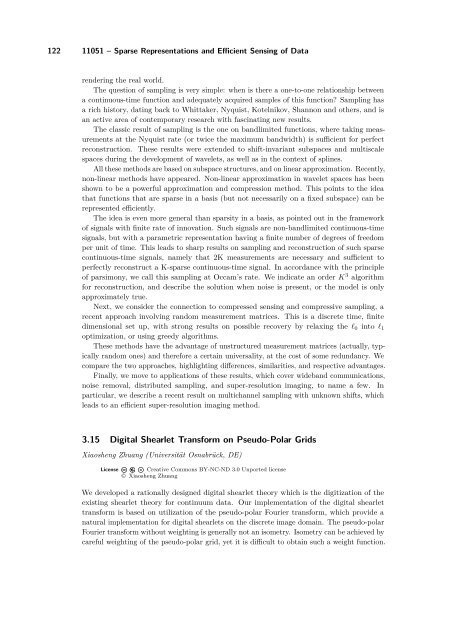Volume 1, Issue 1, January 2011 - DROPS - Schloss Dagstuhl
Volume 1, Issue 1, January 2011 - DROPS - Schloss Dagstuhl
Volume 1, Issue 1, January 2011 - DROPS - Schloss Dagstuhl
Create successful ePaper yourself
Turn your PDF publications into a flip-book with our unique Google optimized e-Paper software.
122 11051 – Sparse Representations and Efficient Sensing of Data<br />
rendering the real world.<br />
The question of sampling is very simple: when is there a one-to-one relationship between<br />
a continuous-time function and adequately acquired samples of this function? Sampling has<br />
a rich history, dating back to Whittaker, Nyquist, Kotelnikov, Shannon and others, and is<br />
an active area of contemporary research with fascinating new results.<br />
The classic result of sampling is the one on bandlimited functions, where taking measurements<br />
at the Nyquist rate (or twice the maximum bandwidth) is sufficient for perfect<br />
reconstruction. These results were extended to shift-invariant subspaces and multiscale<br />
spaces during the development of wavelets, as well as in the context of splines.<br />
All these methods are based on subspace structures, and on linear approximation. Recently,<br />
non-linear methods have appeared. Non-linear approximation in wavelet spaces has been<br />
shown to be a powerful approximation and compression method. This points to the idea<br />
that functions that are sparse in a basis (but not necessarily on a fixed subspace) can be<br />
represented efficiently.<br />
The idea is even more general than sparsity in a basis, as pointed out in the framework<br />
of signals with finite rate of innovation. Such signals are non-bandlimited continuous-time<br />
signals, but with a parametric representation having a finite number of degrees of freedom<br />
per unit of time. This leads to sharp results on sampling and reconstruction of such sparse<br />
continuous-time signals, namely that 2K measurements are necessary and sufficient to<br />
perfectly reconstruct a K-sparse continuous-time signal. In accordance with the principle<br />
of parsimony, we call this sampling at Occam’s rate. We indicate an order K 3 algorithm<br />
for reconstruction, and describe the solution when noise is present, or the model is only<br />
approximately true.<br />
Next, we consider the connection to compressed sensing and compressive sampling, a<br />
recent approach involving random measurement matrices. This is a discrete time, finite<br />
dimensional set up, with strong results on possible recovery by relaxing the ℓ0 into ℓ1<br />
optimization, or using greedy algorithms.<br />
These methods have the advantage of unstructured measurement matrices (actually, typically<br />
random ones) and therefore a certain universality, at the cost of some redundancy. We<br />
compare the two approaches, highlighting differences, similarities, and respective advantages.<br />
Finally, we move to applications of these results, which cover wideband communications,<br />
noise removal, distributed sampling, and super-resolution imaging, to name a few. In<br />
particular, we describe a recent result on multichannel sampling with unknown shifts, which<br />
leads to an efficient super-resolution imaging method.<br />
3.15 Digital Shearlet Transform on Pseudo-Polar Grids<br />
Xiaosheng Zhuang (Universität Osnabrück, DE)<br />
License Creative Commons BY-NC-ND 3.0 Unported license<br />
© Xiaosheng Zhuang<br />
We developed a rationally designed digital shearlet theory which is the digitization of the<br />
existing shearlet theory for continuum data. Our implementation of the digital shearlet<br />
transform is based on utilization of the pseudo-polar Fourier transform, which provide a<br />
natural implementation for digital shearlets on the discrete image domain. The pseudo-polar<br />
Fourier transform without weighting is generally not an isometry. Isometry can be achieved by<br />
careful weighting of the pseudo-polar grid, yet it is difficult to obtain such a weight function.













